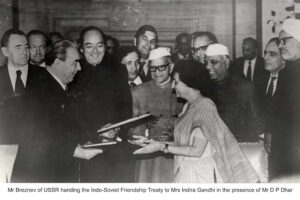On January 4, 1969, Durga Prasad Dhar was appointed Ambassador to the USSR and Mongolia.
D.P. Dhar landed at Moscow airport on a cold January morning in 1969, in the same aircraft that was taking Prime Minister Indira Gandhi ahead to a Commonwealth Heads of Government Meeting meeting in London. It was his first assignment as an Indian ambassador and he arrived at a key moment in Indo-Soviet relations.
Although India was leading the Non-Alignment Movement, American interests in Pakistan had brought India and the Soviet Union closer together. Following the Sino-Indian War of 1962, India had begun receiving military assistance and armaments from the USSR. The Indo-Pakistan War of 1965 further increased New Delhi’s defence dependence on Moscow.
D.P. Dhar took over the ambassadorship with a clear mandate to deepen the relationship, not just militarily, but across spheres. The idea was to bring the Soviets to the negotiating table and sign a treaty that would cement their ties in the long-run. It was an unenviable task, but there were few more qualified to make it happen than D.P. Dhar.
“Diplomacy was new to him, and his critics predicted that he had gone to meet his Waterloo,” stated a New York Times profile on him, adding, “Two years later Mr. Dhar returned home a hero, having brought New Delhi and Moscow together.”
Signing The Indo-Soviet Peace Treaty (1971)

Soviet Premier Brezhnev and Indira Gandhi with DP Dhar (centre) at the signing of the Indo-Soviet Peace Treaty. 9 August 1971.
In February 1969, shortly after taking office, Ambassador Dhar expostulated to Soviet Premier Alexei Kosygin about their recent supply of arms to Pakistan, and that’s when the idea of an Indo-Soviet treaty first came up. It was formally put forward by Defence Minister Marshal Grechko in his talks in New Delhi with Defence Minister Swaran Singh on March 2, 1969. He carried a letter by Brezhnev to Indira Gandhi dated February 28, 1969 that suggested that the two countries enter into a treaty.
However, it took another two years of negotiations as Ambassador Dhar and his team in Moscow laid the groundwork for the treaty. With the crisis in East Pakistan (soon to be Bangladesh) deepening, Indira Gandhi wanted Dhar back in Delhi. In August 1971, he stepped down as Ambassador to the Soviet Union, bringing his first, highly successful term to an end. Mrs. Gandhi immediately appointed him Chairman of the Policy Planning Committee in the Ministry of External Affairs, a role that positioned him as one of the chief architects of Bangladesh’s liberation.
Even after the first term of his ambassadorship was over, Dhar continued to play a key role in Indo-Soviet relations. His carefully cultivated relationship with the Kremlin leadership proved to be most useful. On August 4, 1971, Dhar flew to Moscow as a special envoy for Mrs. Gandhi. Diplomatic observers believed that with increasing tensions between India and Pakistan, India wanted a commitment from the Soviets that they would help in the event of a Pakistani attack. A few days later, Soviet Foreign Minister Andrei A. Gromyko arrived in India as a gesture of solidarity.
On August 9, 1971, Dhar’s relentless efforts and two years of work came to fruition as the historic Indo-Soviet Peace Treaty of Peace, Friendship and Cooperation was finally signed. It became the deciding factor in Indo-Pakistan War later that year and in the liberation of Bangladesh. To learn more about the treaty negotiations, read A.G. Noorani’s account here.
Continued involvement in Indo-Soviet relations
Even after the end of his first term as Ambassador and the thawing of tensions with Pakistan, Dhar continued to be a key man in all matters regarding the Soviet Union. As Minister of Planning in the Union Cabinet, he traveled to Moscow several times to negotiate trade agreements.
In November 1973, when Soviet President Brezhnev arrived in Delhi to meet Indira Gandhi, Dhar led the talks on behalf of the Indian side.
Second Term as Ambassador to the USSR
On February 1, 1975, D.P. Dhar was re-appointed Ambassador to the Soviet Union. Unfortunately, his second tenure was short-lived as he succumbed to a heart ailment on 12 June 1975.
In the four months that he spent in Moscow during his second term, Ambassador Dhar had a grand vision for the development of Indo-Soviet relations. Following his first term and his trade engagement with the Soviets as Minister of Planning, he had a level of Soviet expertise none in Mrs. Gandhi’s cabinet could match.
TP Sreenivasan, then working as the head of chancery at the embassy in Moscow, recounts, “He had the gift of spotting talent and making use of it. Apart from Fotedar [his personal secretary], he brought Gopi Arora as minister (economic), even though Peter Sinai, as the deputy chief of mission, was already entrusted with economic work. He trusted both of them and made them work as a team. He brought my batchmate P K Singh along, but put me with him to work as a team of political assistants to him. Outside the embassy, his confidant was Parayil Unnikrishnan, the PTI chief in Moscow.” (Read more of TP Sreenivasan’s recollections here.)
A True Ambassador
The Embassy of India to the Russian Federation honoured the Late Ambassador D.P. Dhar on 26 June 2021. The D.P. Dhar Memorial Hall at the Indian Embassy in Moscow has been named after him.